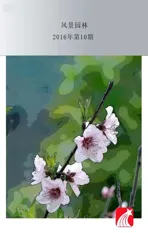刊首语
2016-05-12王向荣
刊首语

1990年代初,中国的报纸一般只有4版,最多不会超过8版,所以当我那时刚跨出国门,看到许多欧洲报纸都有厚厚的近百页时,感到非常新奇。那些报纸经常有关于艺术、设计和城市发展的板块,主要内容是艺术、规划和设计评论,尽管面对的读者是普通民众,但几乎所有评论都极为严肃和专业,有些甚至附有图纸和模型照片。频繁刊登的评论让公众深入了解了艺术家和设计师的作品,他们的工作方式、思想体系和理论学说,培养了公众对艺术和设计的鉴赏能力,也提高了他们参与和评价艺术及设计作品的热情。难怪欧洲大众对已经建成、即将建造、甚至只有方案,未必实施的建筑和景观作品都非常熟悉,都能说出一大串艺术家或是设计师的名字。当然,这些评论对艺术家和设计师来说也意义重大,因为通过评论,艺术家和设计师能听到更多公众的声音,也可以增进交流,活跃思想,反思自己,提高设计水准,更重要的是,被评论就是艺术家和设计师工作生活的一部分,也是他们作品的一部分。艺术家和设计师愿意甚至渴望被评论,因为不被评论的人意味着无足轻重,不被评论的思想意味着不具影响,不被评论的作品意味着不受关注。
那个年代,传媒远不如现在发达,国际上风景园林方面的专业杂志种类也有限,但几乎每一本专业杂志都不会缺少评论,这些评论以读者来信、人物与作品介绍、书评等方式呈现出来,当然几乎所有的介绍都来自于第三方,很少有设计师自己阐释个人的作品。
当时我深深地体会到评论对风景园林在交流、争鸣、反思和进步中的价值,也非常希望中国的风景园林界能开展全面的评论。然而,20多年过去了,今天中国的风景园林似乎并没有发展起健康的评论。尽管各类评论文章也不少,但是人物的评论往往是晚辈写前辈,当然都是一片赞誉;作品的评论往往是设计者的自我介绍,自己解释,避实就虚和夸大其词普遍存在,而思想和理论的评论则是少之又少了。
风景园林评论就是对风景园林所涉及的层面,包括对人物,事情、作品、著作、理论、观点等进行判断和评价,专业的评论需要现场观察、资料阅读、与设计师的讨论和深入的研究等。如果具有一定的专业素养、敏锐的思维和客观的心境,进行风景园林评论并不难,因为在今天,任何评论者都能非常容易地获得较为全面的资料信息、并亲临现场考察,甚至有机会与被评论者进行深入交流。
然而,由于历史和文化的原因,在中国开展评论又并非易事。评论不仅要梳理出被评论客体特殊的价值和品质,更要揭示其存在的问题,然而我们却缺少健康的互相批评的传统,人人都只喜欢听好听的,评论者很难超脱于中国式的人情世故和复杂的利益纠缠之外,做出客观的评论。
评论不容易开展的另一个原因在于,任何评论都需要承载的媒介,对于专业媒体而言,刊登评论总会有一些压力。尽管严肃的评论人人爱看,评论也有利于明辨是非,但是由于不少对事不对人的评论,最终都有可能演化成对人不对事的结果,所以许多专业媒体对刊登笔锋犀利的评论都有所顾虑,怕一旦发表会惹恼了被评论的对象,从而不得不放弃一些好的评论文章。
评论不易还在于,风景园林涉及到广泛的社会、人文和艺术领域,尽管在不同的时代,人们总是尝试寻找蕴含在景观客体中恒定的并普遍适用的思想、规范和标准,以此建立景观实践的准则,但是对同一件作品,评论者与设计师和大众的普遍感受往往并不一致,评价的标准又如何确定呢?
正是由于评论没有固定的模式,景观的作品也没有统一的标准,所以评论也往往会带来争议,评论也会被再评论,所以应当允许评论者具有相当程度的主观性,带有个人的观点和立场,但这种主观性的前提必须是评论者具有良好的知识储备、正面的价值取向和无私的品质,是在进行充分研究后做出的理性判断,评论必须有理有据并符合基本事实。
在互联网日益发达的今天,评论必然出现多元化和多途径的局面。现在每个人都可以对风景园林的任何层面进行评论,表达自己的看法,并借助于新媒体迅速广泛地传播。新媒体为评论创造了以往难以想象的宽松氛围,但无论通过怎样的媒介进行评论,有价值和健康的评论永远是理性的和严肃的,这些评论不会为了某些利益夸大或做有利或不利的选择,更不会利用评论来宣泄私愤。
PREFACE
At the beginning of the 1990s, the newspapers in China were only about four editions, and no more than eight generally. So I was surprised when fi rst got abroad and saw newspapers in Europe with nearly a hundred pages. These newspapers often include sections about art, design and urban development, presenting the reviews and comments on art, planning and design. Although facing with the readers mostly ordinary public, almost all the reviews are serious and professional, even with drawings and modeling photos. Frequently published reviews provide the public with a deeper understanding of the work of artists and designers, along with their ideology and theory, cultivating public appreciation of art and design, enhancing public enthusiasm of the participation and evaluation of art and design works. No wonder that the European public is mostly very familiar with the architecture and landscape works that have been built, will be built, or even those only in the program process and may not be implemented, they can easily list plenty of artists' or designers' name. For certain, these reviews are also signi fi cant for artists and designers. Via the comments, artists and designers can get widely access to the public voices, therefore enhancing communication and active thinking, reflecting on their works, improving the design standards. More important, being commented is part of their work and life for artists and designers, who are actually willing and even eager to be commented. Because not being commented means insigni fi cant, the idea fail to gain public review are mostly not in fl uential, and the works without public review refers to the lacking of social concern.
At that time, media is far inferior to today's prosperity, the professional magazines in the field of landscape architecture are limited worldwide, but reviews is never absent in almost every professional magazine. These reviews were presented in reader letters, figures, work introductions, book reviews, etc. Of course, almost all of the introductions are from a third party, very few designers presenting their own works.
I deeply realized the value of review in idea exchange, contention, re fl ection and progress of landscape architecture, and also eagerly hope that landscape architecture in China may carry out comprehensive review through various platforms. However, more than 20 years past, healthy review does not seem to develop in the professional fi eld. Though reviewing essays emerge frequently, comments on fi gures are mostly praises from the young generations for the predecessors, while reviews on projects are often the designer's self-introduction and interpretation, evading the drawbacks and over praising the strengths. Few reviews and criticisms focus on the idea and theory.
Landscape architecture review refers to the judgments and evaluation on all levels of landscape architecture, including the fi gures, affairs, projects, researches, theories, and viewpoints etc. Professional review requires on-site observation, data comprehending, in-depth research and even discussion with designers. With certain professional qualities, keen thinking and objective state of mind, review on landscape would not be dif fi cult, because of the easy access to any comprehensive information and data, as well the personal visit onsite, and even the opportunity of face-to-face communication with the designers.
However, due to historical and cultural background, carrying out reviews in China is quite hard. Reviews not only need to put forward the special value and quality of the target, but also reveals its drawbacks. Yet, a healthy tradition of mutual criticism is hardly formed. Everyone likes to be complimented, thus reviewers are hard to make objective comment surpassing the sophistication and complexity of the interests and social relations.
What also accounts for hardness of review is that reviews need to be carried by the media. More or less pressure exists for the professional media to post reviews. Although serious reviews may be popular and may help professionals distinguish right from wrong, many of the criticizing reviews toward ideas rather than people eventually evolve into negative results against certain person. So many professional medias avoid publicizing sharp comments, just in case stirring up the one being commented, thus giving up some high-standard reviewing articles.
It is hard for landscape architecture review to popularize also because the subject involves a wide coverage of society, humanity and art fields. For various decades, people always try to fi nd ideas, norms, and standards that are constant and universally applicable so as to form a criteria for landscape practices. However, with regard to the same piece of work, the perspective of reviewers, designers and the general public are often inconsistent, then how to formulate the evaluation criteria?
It is precisely because no fixed standard for landscape works exist, there is no uniform model for reviews, so the comments are often controversial, and comments will be re-commented. A considerable degree of subjectivity, personal views and positions should be accepted, yet only when the reviewer has a good knowledge reserve, a positive value orientation and a disinterested position, forming rational judgment along with comprehensive study and justi fi ed facts.
In today's internet prosperity, reviews are inevitably facing with a diversified and multipath situation. Everyone can comment on any aspect of landscape architecture, expressing their viewpoints, quickly and widely spreading with the help of new media, which creates an unprecedented loose atmosphere for reviews. But no matter through which media the reviews spread, valuable and healthy reviews are always rational and serious, without exaggeration, favoritism or the venting of private emotions.
October 18, 2016 WANG Xiang-rong
